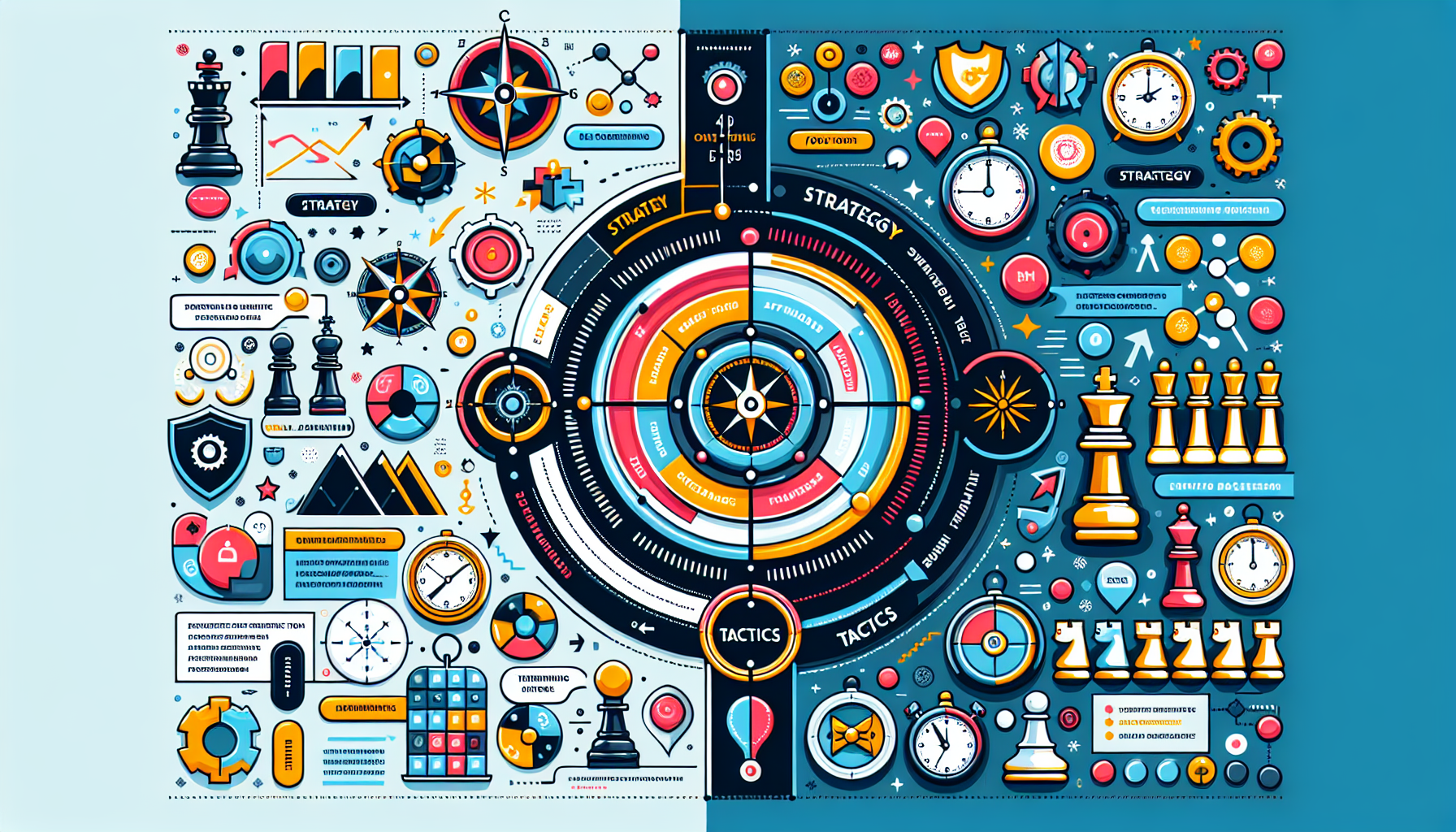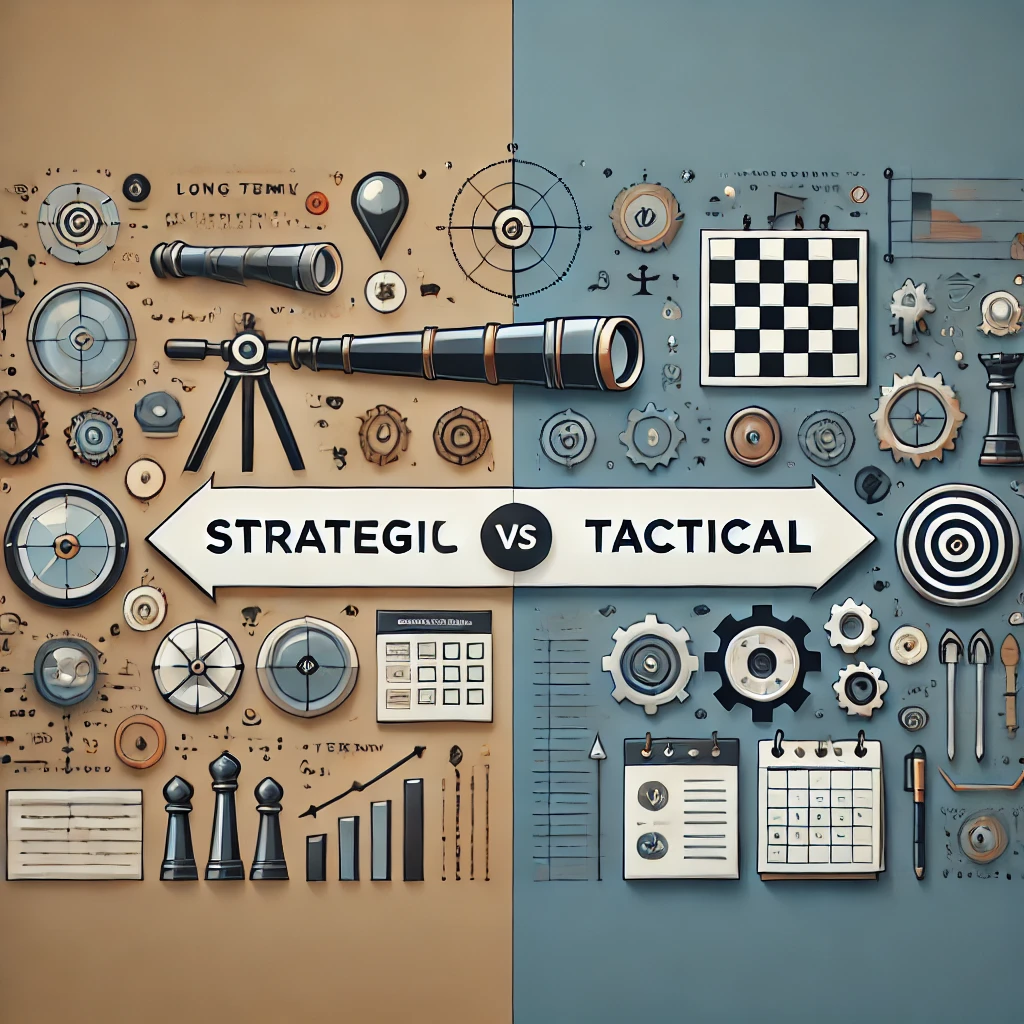Strategically vs. Tactically: Key Differences and Benefits Explained
When should you think strategically vs tactically? Understanding the difference and looking at strategic vs tactical planning can be crucial for effective planning and execution in business and beyond. While strategic planning focuses on long-term goals and the big picture, tactical planning breaks these goals down into actionable steps. This article will explore these concepts in-depth, helping you leverage both for success.
Key Takeaways
- Strategic planning provides a long-term vision and overarching goals, while tactical planning outlines specific, actionable steps for achieving short-term objectives.
- Successful organizations balance both strategic and tactical planning to ensure coherent and adaptable efforts towards common goals, resulting in potential growth of up to 30%.
- Effective planning requires clear vision, alignment with company values, flexibility, and regular progress assessments to adapt to changing environments and maintain organizational focus.
Unlock Your Business Potential Today!
Ready to take your business planning to the next level? Book a free consultation now and discover how strategic and tactical planning can accelerate your growth. Click here to schedule your call!
Understanding Strategic and Tactical Planning

Business success requires both strategic and tactical planning. Strategic planning acts as the compass, offering the organization a long-term vision and overarching goals. Strategy defines an organization’s long-term goals, providing a framework for achieving these objectives through strategic planning. Conversely, tactical planning serves as the map, outlining the steps needed to achieve these goals within a shorter timeframe. Understanding the difference between strategic vs tactical planning can significantly influence an organization’s success in reaching its objectives.
Companies that effectively utilize both strategic and tactical planning can grow up to 30 percent faster than those that do not. While strategic planning sets the overall direction, tactical planning translates it into actionable steps. Mastering these concepts enables organizations to create more effective and adaptable strategies, aligning all efforts toward common goals through strategic and tactical thinking.
Defining Strategy: The Long-Term Vision
Strategic planning focuses on the big picture. It involves developing a living document that outlines an organization’s long-term vision and goals. This plan should incorporate input from various stakeholders and align with both internal and external conditions. A strategic plan generally covers a long-term perspective, aiming to achieve bigger-picture goals over an extended period.
Effective strategic planning demands a thorough analysis of past performance and present capabilities. This process includes evaluating the market, competitors, and internal strengths and weaknesses. Through such evaluations, organizations can create a future state that articulates desired outcomes and overarching goals.
Collective ownership by the senior management team greatly influences the success of a strategic plan.
Transform Your Strategies into Success
Struggling to align your strategic goals with actionable steps? Let’s work together to create a roadmap for your business success. Schedule a 15-minute call with me today. Book your consultation now!
Defining Tactics: Short-Term Actions
Tactical planning focuses on immediate needs, outlining specific, actionable steps to achieve short-term goals, typically within a year. It converts broader strategic objectives into smaller, manageable tasks that align with the department’s priorities for departmental implementation.
A tactical plan specifies the steps and actions necessary for a business to achieve its goals. This involves setting milestones and deadlines to guide the implementation process.
Regular progress assessments ensure alignment with strategic goals and facilitate timely adjustments. Essentially, tactical planning ensures tasks are executed effectively and within the defined timeframe.
Achieve Consistent Growth and Success
Don’t let poor planning hold your business back. Discover how a balance of strategic and tactical planning can drive your business forward. Schedule your free call today!
Key Differences Between Strategy and Tactics

Though complementary, strategy and tactics serve different purposes. Strategy refers to a forward-looking action plan aimed at achieving long-term goals. It links short-term actions to long-term goals, offering a broader context for organizational objectives.
Conversely, tactics are inherently short-term, designed to achieve immediate objectives. They comprise specific actions and steps necessary to implement the strategy. Tactics misaligned with strategy can lead to aimless work and reduced effectiveness.
Balancing both strategy and tactics enables organizations to ensure consistent growth and success.
Characteristics of Effective Strategic Planning

Effective strategic planning encompasses several key characteristics. These include a clear vision and objectives, alignment with company values, and the flexibility to adapt to changes in the business landscape.
Clear Vision and Objectives
A clear vision is a guiding star for strategic objectives, ensuring organizational alignment toward common goals. This vision should be ambitious yet attainable, inspiring employees and clarifying the organization’s aims. Long-term goals should be specific and measurable, ensuring alignment with company objectives.
A well-defined vision inspires employees and aligns their efforts toward common goals. This alignment is crucial for maintaining focus and ensuring that all actions contribute to larger strategic objectives.
Alignment with Company Values
Strategic goals must align with the company’s core values to remain sustainable and motivating. Goals that support the organization’s mission and convictions ensure everyone works towards a common purpose, fostering employee engagement and a consistent organizational culture.
Flexibility and Adaptability
Flexibility in strategic planning is crucial for adapting to rapidly changing environments. Strategic plans should be designed to evolve in response to shifts in the business landscape. This adaptability ensures the organization remains competitive and effectively responds to new opportunities and threats.
Characteristics of Effective Tactical Planning
Effective tactical planning requires a well-defined purpose, detailed timeline, impact measurement, and resource needs. Leaders must accurately detail their tactical approaches to ensure successful implementation.
Detailed Timelines and Resource Allocation
Setting deadlines for each tactical step is vital for maintaining focus and momentum. Detailed timelines help keep the team organized and ensure all tasks are completed within the specified timeframe. Effective task delegation enhances team collaboration and ensures skill alignment, facilitating achieving desired outcomes.
Resource allocation is another crucial aspect of tactical planning. Assigning the right resources to the right tasks enhances accountability and ensures the necessary tools and personnel are available to achieve set goals.
Specific, Measurable Goals
Tactical plans should include specific, measurable goals for clear focus and accountability. Dividing strategic goals into smaller tasks makes it easier to assess their success against benchmarks and ensures each step contributes to broader objectives.
Frequent Progress Measurement
Regular progress reviews are essential to identify obstacles and adjust tactics promptly. Smaller goals within a tactical plan should be structured for easier progress tracking. Regular assessment allows for timely updates and realignment with strategic objectives, ensuring the organization remains on track to achieve its goals.
How to Create a Strategic Plan
Creating a strategic plan begins with considering general business objectives. This process involves evaluating the current position, setting long-term goals, and defining success metrics to measure progress.
Evaluate Current Position
Using data to evaluate the current company position is crucial for informing strategic planning and gaining a competitive advantage. Tools like SWOT analysis aid in recognizing opportunities, threats, strengths, and weaknesses.
These evaluations significantly inform and shape future strategic decisions.
Set Long-Term Goals
When setting long-term goals, it is crucial to consider the company’s mission. These goals should align with the organization’s broader strategic vision and provide direction for future actions.
Define Success Metrics
Incorporating measurable metrics in strategic plans is crucial for evaluating progress and success. Metrics such as financial figures, customer satisfaction scores, and project milestones help track strategy and tactic effectiveness.
Regular assessments ensure the plan remains aligned with organizational goals.
How to Create a Tactical Plan
Creating a tactical plan involves setting clear, actionable goals aligned with the organization’s mission. This process includes breaking down strategic goals, assigning responsibilities, and frequently monitoring progress.
Break Down Strategic Goals
A tactical plan divides long-term goals into smaller tasks. This approach helps visualize progress toward overall strategic objectives and ensures each step is manageable and achievable.
Consider the time, skills, and resources required for each goal when setting smaller tasks.
Assign Responsibilities
In tactical planning, it is crucial to identify the needed teams, assess personnel expertise, and assign roles accordingly. Clear timelines and role specifications enhance accountability and ensure all efforts align with strategic goals.
Monitor and Adjust Frequently
Constant progress monitoring ensures alignment with strategic objectives and facilitates timely adjustments. Setting clear metrics and KPIs, conducting regular reviews, and establishing feedback loops effectively track progress.
Examples of Strategic and Tactical Outcomes

Consider a local government aiming to improve transparency to illustrate the differences between strategic and tactical planning. The strategic goal might involve adopting new communication channels, while tactical actions could include creating a community dashboard and organizing town hall meetings.
In education, a strategic goal could be enhancing student engagement through technology. Tactics to support this goal might include purchasing smart systems and providing teacher training. These examples highlight how strategic and tactical planning work together to achieve specific outcomes.
Get Expert Guidance on Business Planning
Confused about strategic vs. tactical planning? Let’s clarify your path to success. Book a free 15-minute call with me and start achieving your business goals. Click here to book now!
Benefits of Strategic Planning
A strategic plan serves as a roadmap outlining an organization’s direction and objectives. It fosters a proactive approach, enabling organizations to anticipate market changes and maintain a competitive edge. Identifying unique market opportunities and aligning with core values increases the likelihood of achieving long-term objectives through strategic planning.
Strategic plans must resonate with the organization’s core values to be effective. This alignment ensures the strategy is motivating and sustainable, providing a clear roadmap for the team. A well-crafted strategic plan helps organizations stay focused on their long-term vision and adapt to evolving market conditions.
Benefits of Tactical Planning
Tactical planning enhances alignment and collaboration among team members. By prioritizing immediate initiatives that contribute to broader strategic objectives, tactical planning ensures effective resource allocation and efficient task execution.
Tactical planning supports strategic execution by focusing on short-term operational decisions. This approach helps optimize workflows, minimize resource wastage, and improve overall execution, leading to better organizational outcomes.
Integrating Strategic and Tactical Plans

Integrating strategic and tactical plans is essential for cohesive execution. Tactical plans should align closely with the overarching goals of the organization, ensuring all departments work towards shared objectives. Engaging stakeholders from different levels fosters a more cohesive integration of strategic and tactical efforts.
Using tools like the balanced scorecard can aid in integrating strategic goals with tactical actions effectively. This integration enhances organizational alignment and improves decision-making by providing a framework for evaluating options.
By aligning tactical actions with strategic goals, organizations can quickly respond to changes in the business environment while staying focused on their long-term vision.
Maximize Your Business Potential
Want to see real growth in your business? Leverage the power of strategic and tactical planning with expert guidance. Book a call now to get started!
Summary
Strategic and tactical planning is crucial for achieving business success. Organizations can create more effective and adaptable strategies by understanding their differences and benefits. Integrating these plans ensures cohesive execution and alignment with long-term goals, paving the way for sustained growth and success.
Frequently Asked Questions
What is the main difference between strategic and tactical planning?
The main difference between strategic and tactical planning lies in their focus; strategic planning addresses long-term goals and the organization’s overall direction, while tactical planning concentrates on short-term actions and specific steps to achieve those goals.
How often should a strategic plan be revisited?
A strategic plan should be revisited regularly to adapt to changes in the business environment and ensure it remains aligned with evolving market conditions. This proactive approach facilitates sustained organizational success.
What tools can assist in the strategic planning process?
Effective tools for strategic planning are the Balanced Scorecard and SWOT analysis, as they assist in assessing the current situation and establishing long-term objectives. Utilizing these tools enhances clarity and focus in the planning process.
How do you ensure tactical plans align with strategic goals?
To ensure tactical plans align with strategic goals, it is essential to decompose these goals into specific, manageable tasks with defined timelines and resource allocation. This approach facilitates a clear connection between daily operations and overarching objectives.
What are some examples of strategic and tactical outcomes?
Enhancing student engagement through technology is a strategic outcome, while the tactical actions involve purchasing smart systems and providing teacher training. These illustrate how strategic goals can be achieved through specific, actionable steps.



